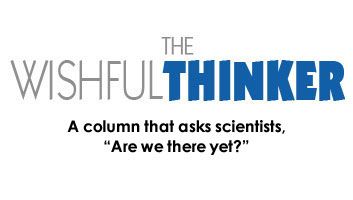Personal Genome Project
These holidays, give the people who have everything the one thing they don’t: a map of their own DNA
/https://tf-cmsv2-smithsonianmag-media.s3.amazonaws.com/filer/wishful-dec07-631.jpg)
The holidays bring out the wishful thinker in all of us. Some of us pine for that car that folds up into a suitcase. Others hope for something more eco-friendly, like a matter transporter. A few unreasonable souls wish for things like happiness or health.
None of these gifts, at present, is available at Wal-Mart, or even eBay. But what if you could give the gift of, say, health—in the form of a personal genetic analysis? When can we spit on a lab slide and, a few months later, know the various conditions our body might endure in the coming years? When can we put down our Magic-8 Balls and truly get a glimpse into the future?
The human body contains about 20,000 genes that together make up its DNA, or full genome. DNA consists of three billion pairs of four chemicals—A's, T's, C's and G's, as they're known. The order of these chemicals, in a sense, creates the blueprint that becomes a person.
Common gene sequences have been around for thousands of generations. Sometimes, usually within the past hundred or so generations, variations of certain genes appear. These abnormalities can be correlated with, or even cause, unhealthy conditions. A personal genome map would identify which variations a person has, and therefore which illnesses might be predetermined.
Until very recently, such omniscience has come at a steep cost. Completing the Human Genome Project, the groundbreaking analysis of a full-body double helix, took a vast collection of the world's best scientists about 13 years and cost some $3 billion.
For about a grand, a person can have his or her DNA analyzed by what's call an SNP chip. Affordable, sure. Problem is, an SNP chip—which stands for single nucleotide polymorphism—looks at only .03 percent of the full genome. What's more, this glimpse is the .03 percent most common to everyone. In large enough bundles, such snippets can benefit researchers. If a population with a certain illness shows a slight excess in a particular base-pair, scientists can go back and study that anomalous sequence in greater detail. Over time, they might even detect a disease correlation. But, on a singular level, an SNP chip can't isolate genetic oddities. For a holiday wishful thinker, the method is, at best, a stocking stuffer.
Using the latest technology, however, scientists can combine the thoroughness of the Human Genome Project with the mom-and-pop convenience of the SNP chip. The key is shifting the chemical world into the digital world. In other words, geneticists can alter DNA so that it takes a form recognizable by standard computers. The machines can take over from there.
Enzymes in a person's body work with DNA, and geneticists can rig these enzymes to carry fluorescent tags. That way, the base-pairs that make up our genes appear as different colors. Just as a digital camera collects photons and reproduces them as an arrangement of pixels that resembles the original image, genome machines can gather these tinted base-pairs and identify individual gene sequences. It's your basic paint-by-number, come to life.
For the person being examined, the procedure is startlingly simple. All it takes is a drop of saliva or blood. Then a half dozen or so machines, each about the size of a small dishwasher, find the sequence and compare it to the human genome reference available on the Internet.
The computers then create a list of genetic variations, ranked by order of health risk, which can be delivered to a person's computer, or even a cell phone. A person can receive updates to his genome as scientists add to the literature of 3,000 or so disease-related genes. The person can peruse the list until becoming overwhelmed, anxious or bored enough to move on to the next holiday gift.
Right now, a personal genome analysis has its limits. At $350,000, a lucky child might receive the gift in lieu of, say, a college education. The process is also restricted by the current state of research: Computers can't give feedback about disease-related variations that haven't yet been discovered. People who get their genome sequenced must understand the chance of a false positive—that is, the indication of a genetic risk that fails to reach fruition. And, though unlikely, a person must be prepared to find out that a potentially fatal disease is coded into his or her system. Now aren't you glad you asked for that matter transporter instead?
The real wishful thinker behind this column was George Church, a geneticist at Harvard University and founder of Knome, the first company to offer individuals a full genome sequence.
Have an idea that should be thought about wishfully? Email it to [email protected]
/https://tf-cmsv2-smithsonianmag-media.s3.amazonaws.com/accounts/headshot/eric-jaffe-240.jpg)

/https://tf-cmsv2-smithsonianmag-media.s3.amazonaws.com/accounts/headshot/eric-jaffe-240.jpg)